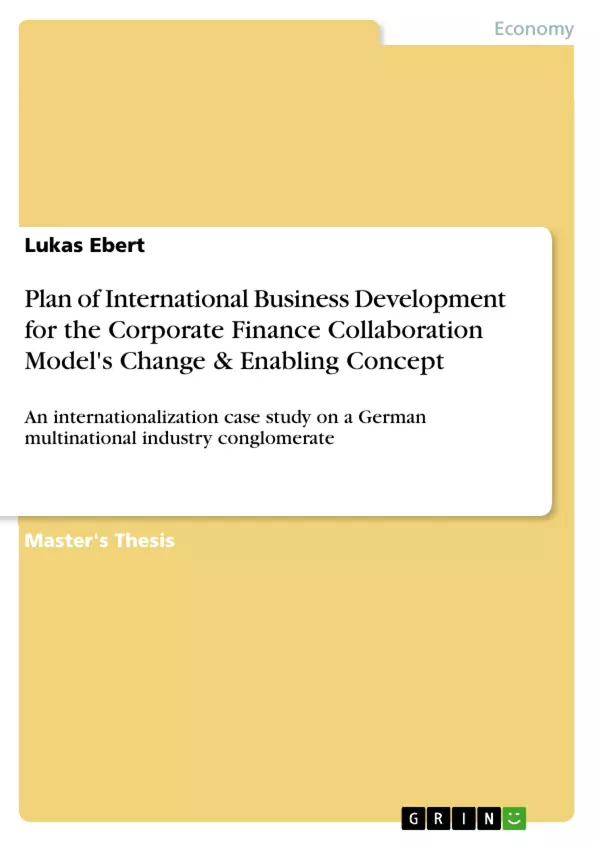The megatrend of globalization has been influencing and is still shaping private as well as corporate life. This “inevitable wave of the future (…) is frequently confused with internationalization, but is in fact something totally different.”. For this reason, it is pertinent to elaborate on this issue later on in the literature review because a shared understanding is key in order to provide correct and generalizable results by means of this paper.
For a comprehensive understanding of the underlying problems and derived goals for the paper and the project, it is necessary to highlight another trend, whose origin can be traced back to aforementioned one: In addition to the increasing competitive pressure, primarily in the currently disruptively changing automotive and supply industry, the trend of the so-called renaissance of accounting is having far-reaching consequences. Since about 2010, the enormous potential for improvement in the financial sector has been (re)discovered, resulting in the necessity for various analyses with an internal and external focus, in which the existing processes were examined with regards to performance and compared to competitors by benchmarking oneself.
Inhaltsverzeichnis (Table of Contents)
- Preface
- Table of contents
- Glossary
- List of figures
- List of tables
- 1 Introduction
- 1.1 Embedment in the overall context
- 1.2 Scope of application
- 1.3 Definition of problems and respective goals
- 1.4 Structural approach of the paper
- 2 Literature review and theoretical background
- 2.1 Internationalization and other key terminology
- 2.2 Necessity for and modelling of Change Management
- 2.3 Influence of corporate and national cultures
- 3 Analysis and generation of insights
- 3.1 Environment and the origin of the project
- 3.2 Stakeholder and risk assessment
- 3.3 Internal competitive situation and customer requirements
- 3.4 Study of target regions
- 4 Strategy development and evaluation
- 4.1 Derivation of options
- 4.2 Evaluation and implementation
- 5 Critical review of the approach
- 6 Conclusion
- 6.1 Summary and realization of objectives
- 6.2 Resumé and outlook
- Reference List
- Appendix
Zielsetzung und Themenschwerpunkte (Objectives and Key Themes)
This thesis explores the implementation of a change and enabling concept, referred to as the CF Collaboration Model-Change & Enabling Concept (CMCEC), within a multinational German company. The objective is to examine the project's origin, development, and implementation, taking into account the company's internationalization strategy and cultural considerations. By analyzing the project's environment, stakeholders, and risks, the thesis aims to identify and evaluate the effectiveness of the chosen strategy in achieving the desired outcomes.
- Internationalization Strategies
- Change Management in International Settings
- Cultural Impact on Business Development
- Stakeholder Analysis and Risk Assessment
- Strategic Implementation and Evaluation
Zusammenfassung der Kapitel (Chapter Summaries)
- Chapter 1: Introduction - This chapter provides an overview of the thesis, outlining its context, scope, problem definition, and structural approach. It introduces the CF Collaboration Model-Change & Enabling Concept (CMCEC) and its significance in the company's internationalization strategy.
- Chapter 2: Literature Review and Theoretical Background - This chapter reviews relevant literature on internationalization, change management, and cultural influences in business development. It explores theoretical frameworks and models that underpin the CMCEC project.
- Chapter 3: Analysis and Generation of Insights - This chapter delves into the project's environment, including the origin of the CMCEC project, stakeholder and risk assessment, internal competitive situation and customer requirements, and a study of target regions.
- Chapter 4: Strategy Development and Evaluation - This chapter presents the development and evaluation of the CMCEC project's strategy. It explores the derivation of options for implementation and evaluates the chosen approach, considering its effectiveness and feasibility.
- Chapter 5: Critical Review of the Approach - This chapter critically reviews the overall approach of the CMCEC project, analyzing its strengths, weaknesses, and potential areas for improvement.
Schlüsselwörter (Keywords)
The key focus areas of this thesis include internationalization, change management, cultural influences, stakeholder analysis, risk assessment, strategic implementation, and evaluation. The project under investigation, CF Collaboration Model-Change & Enabling Concept (CMCEC), serves as a core concept and is analyzed in the context of the company's overall business development strategy.
- Quote paper
- Lukas Ebert (Author), 2019, Plan of International Business Development for the Corporate Finance Collaboration Model's Change & Enabling Concept, Munich, GRIN Verlag, https://www.grin.com/document/1188180



